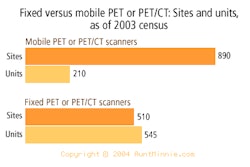The Mini-Mental State Examination (MMSE), developed in the 1970s at the Johns Hopkins Hospital in Baltimore, is a widely used tool for assessing the severity of dementia. The simplified and scored form of a cognitive mental exam includes 11 questions that focus only on the cognitive aspects of mental functions, and takes about five to 10 minutes to administer.
A study presented at the 2004 RSNA conference in Chicago compared MMSE scores with PET and SPECT findings to see if the exam could be used to predict the severity of Alzheimer's dementia on imaging results.
"The purpose of our project was to correlate Mini-Mental State Exam scores with the severity of findings characteristic for Alzheimer's dementia seen in SPECT and PET to see if the MMSE is a valid screening tool for deciding which patients should be evaluated with physiologic imaging," said Amitha Rao, a third-year medical student at the University of Kansas who presented the findings at the conference.
Rao conducted the research with Dr. Reginald Dusing, director of the division of nuclear medicine in the department of radiology at the University of Kansas Medical Center in Kansas City, KA.
The MMSE is divided into two sections, with the first section requiring vocal responses and covering orientation, memory, and attention. The maximum score is 21. The second part of the exam tests the patient's ability to name, follow verbal and written commands, write a sentence spontaneously, and copy a complex polygon similar to a Bender Gestalt figure. The maximum score is nine. A total score of 24 or above is considered normal.
"At our institution, 99 consecutive patients underwent PET or SPECT imaging between January 2001 and July 2003," Rao said. "We excluded patients if they had findings on PET or SPECT suggestive of dementia other than the Alzheimer's type such as Pick's disease or multi-infarct dementia."
Of this cohort, 58 met the Alzheimer's dementia criteria of bilateral temporoparietal defects without evidence of vascular defects on CT or MR structural imaging, according to Rao. The researchers found 15 patients from this group (mean age 68 years) that had a recent MMSE documented no more than six months from than the date of the PET or SPECT acquisition.
"The mean MMSE score of the subjects was 23," Rao said.
Patients who underwent SPECT imaging were injected with 30 millicuries (mCi) of technetium-99m ethyl cysteinate dimmer, and images were acquired on a triple-head SPECT camera with parallel cone collimators, Rao said. Patients who underwent PET imaging were injected with 10 mCi of F-18 FDG and imaged on an ART PET scanner (Siemens Medical Solutions, Malvern, PA). The images were interpreted by two physicians who were both dual-certified in nuclear medicine and radiology.
The five components of the MMSE -- orientation, immediate recall, attention and calculation, recall, and language -- as well as its composite scores were individually compared to the severity of imaging findings ranked on a 5-point scale with 1 for mild to 5 for severe, according to the researchers. They found that the MMSE was not valuable at all in predicting the severity of imaging results.
"I want to stress that many patients with near normal MMSE scores such as 29 or 30 out of a possible 30 points, showed marked, bilateral temporoparietal defects on either PET or SPECT," Rao said. "Other patients with composite scores of 14 out of 30 or 15 out of 30 had only moderate or moderate to severe temporoparietal defects."
The team also looked at the mean MMSE scores and found that none of the components of the MMSE was more sensitive or specific than the composite score, according to Rao.
"While the total number of patients in our study is small, it is significant for a pilot study," Rao said. "Our data tend to support the recent evidence that adding PET or SPECT imaging to the diagnostic algorithm in the evaluation of dementia may hasten the diagnosis of Alzheimer's disease, and thus be more cost-effective and promote a higher quality of life by allowing earlier treatment and remediation than employing only the clinical tools currently in use."
By Jonathan S. Batchelor
AuntMinnie.com staff writer
December 24, 2004
Related Reading
CMS to cover PET for Alzheimer's, September 17, 2004
PET shows promise in differentiating AD from dementia, June 23, 2004
Using PET for Alzheimer's diagnosis lowers cost of care, October 21, 2002
FDG-PET depicts metabolic patterns of Alzheimer's in young adults, July 24, 2002
PET, SPECT differ in Alzheimer's imaging, June 25, 2001
Copyright © 2004 AuntMinnie.com



















